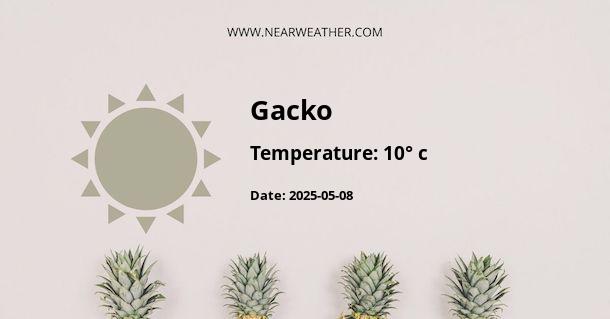Climate and Weather Patterns in Gacko, Bosnia and Herzegovina
The small town of Gacko is situated in the Republic of Srpska, an entity of Bosnia and Herzegovina, known for its complex climate patterns influenced by a mix of Mediterranean, continental, and mountainous weather systems. Understanding the climate and weather in Gacko throughout the year involves examining temperature variations, precipitation levels, and dominant weather events specific to this locale.
Geographic and Climatic Overview
Gacko lies in the southeastern part of Bosnia and Herzegovina, featuring a predominantly continental climate, with certain influences from the Adriatic Sea yielding Mediterranean characteristics, particularly in summer. However, the topography surrounding Gacko, which includes high mountains, can lead to more severe and distinctive local weather patterns.
Temperature Patterns
Temperature fluctuations in Gacko exhibit clear distinctions across the seasons. Here's a breakdown of the temperature regime:
Seasonal Temperature Distribution
| Season | Average High (°C) | Average Low (°C) |
|---|---|---|
| Winter (Dec-Feb) | 4 | -3 |
| Spring (Mar-May) | 15 | 5 |
| Summer (Jun-Aug) | 26 | 14 |
| Autumn (Sep-Nov) | 17 | 7 |
Extreme Temperature Events
Gacko's climate is susceptible to sudden and extreme temperature shifts, which can result in significantly warmer or cooler conditions than the averages presented. These anomalies can be attributed to a variety of atmospheric behaviors, including the influence of Mediterranean cyclones or cold fronts stemming from the north.
Precipitation Patterns
Rainfall in Gacko is generally evenly distributed throughout the year, with no distinct dry season. However, there are fluctuations in moisture levels generally aligning with the seasons:
Seasonal Rainfall Distribution
- Winter: Though the temperatures can be low, Gacko experiences snowfall which contributes to the seasonal precipitation levels.
- Spring: The town sees increased rainfall during the spring months, which contributes to the lush greenery of the region.
- Summer: Despite the warmer weather, Gacko does get occasional heavy downpours, often in the form of thunderstorms.
- Autumn: Rainfall starts increasing in autumn, setting the stage for the wetter winter months.
Annual Precipitation Chart
| Month | Average Precipitation (mm) |
|---|---|
| January | 52 |
| February | 55 |
| March | 60 |
| April | 68 |
| May | 75 |
| June | 80 |
| July | 62 |
| August | 66 |
| September | 70 |
| October | 69 |
| November | 80 |
| December | 68 |
Wind and Other Weather Events
Wind patterns in Gacko can greatly affect the perceived temperature, particularly during the winter months when strong gusts originating from the mountain passes can result in sharp wind chill factors.
Notable Weather Events
- Gacko is sometimes subjected to severe weather phenomena, including hailstorms and thunderstorms, particularly in transitional seasons.
- Occasionally, the town can experience foggy conditions due to temperature inversions, which are common in mountainous regions, leading to transportation disruptions.
- Heatwaves, though less common, can occur during summer, bringing with them the need for increased awareness of heat-related illnesses.
Sunlight and Daylight Hours
The amount of sunlight Gacko receives ebbs and flows with the seasons. Long, sunny days characterize the summer months, while shorter daylight hours are a hallmark of the winter season. Adequate sun exposure plays a vital role in agriculture and outdoor activities, which are significant aspects of life in Gacko.
Average Daylight Hours by Season
Spring and summer in Gacko usher in approximately 14 to 16 hours of daylight, which progressively decrease to 8 to 10 hours as autumn and winter settle in. This pattern aligns with the town's latitude and its position on the Earth's tilt.
Human Impacts on Climate and Weather
While Gacko has a robust natural climate system, human activities such as land use change and emissions from the local coal-fired power plant can impact weather patterns. Environmental regulation and monitoring are essential to ensuring that the impacts remain minimal and do not significantly alter the local climate over time.
Climate Adaptation and Strategies
Residents of Gacko and local authorities are increasingly aware of the need to adapt to climate change. Strategies include improved water management systems, sustainable farming practices to cope with varying precipitation patterns, and enhancing infrastructure to withstand extreme weather events.
Preparation for Seasonal Weather
Being prepared for the seasonal shifts in weather is crucial for safety and comfort in Gacko. Winter preparations often involve securing adequate heating resources and preparing for snowfall, while summer might require planning for adequate hydration and protection against heatwaves. The local advice suggests awareness of weather forecasts and having contingency plans for severe weather incidents.
Engagement and Education
Community engagement through education about the local climate fosters a culture of preparedness. Workshops on climate resilience and sustainability can help Gacko's residents better anticipate and respond to weather-related challenges.
In summary, Gacko features a rich tapestry of weather patterns shaped by its continental and Mediterranean influences. Understanding these patterns is critical for local planning, agriculture, and daily activities. The community's approach to adapting and preparing for weather shifts serves as a framework for other towns in similar climatic regions.
A - Gacko's Latitude is 43.167221 & Longitude is 18.535280.
A - Weather in Gacko is 14° today.
A - Climate Conditions in Gacko shows overcast clouds today.
A - Humidity in Gacko is 79% today.
A - Wind speed in Gacko is 11.45 km/h, flowing at 41° wind direction. today.
